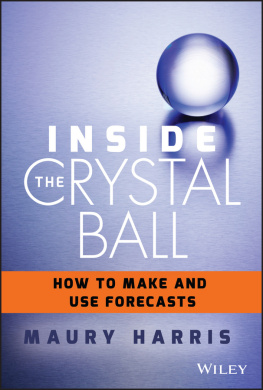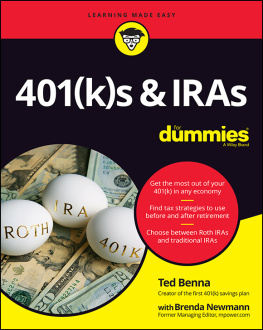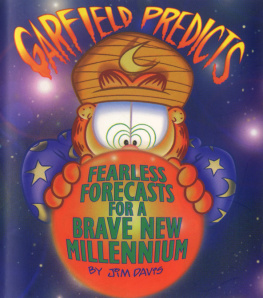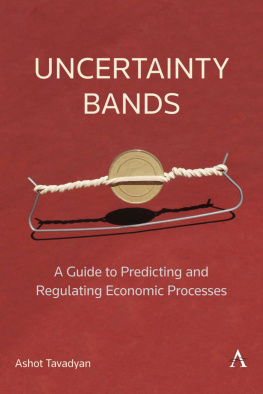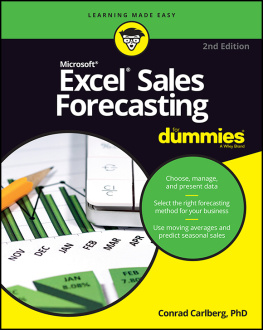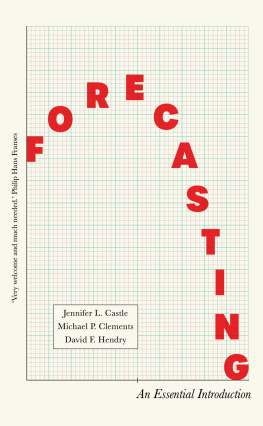
Cover Image: iStock.com/wragg
Cover Design: Wiley
Copyright 2015 by Maury Harris. All rights reserved.
Published by John Wiley & Sons, Inc., Hoboken, New Jersey.
Published simultaneously in Canada.
No part of this publication may be reproduced, stored in a retrieval system, or transmitted in any form or by any means, electronic, mechanical, photocopying, recording, scanning, or otherwise, except as permitted under Section 107 or 108 of the 1976 United States Copyright Act, without either the prior written permission of the Publisher, or authorization through payment of the appropriate per-copy fee to the Copyright Clearance Center, Inc., 222 Rosewood Drive, Danvers, MA 01923, (978) 750-8400, fax (978) 646-8600, or on the Web at www.copyright.com. Requests to the Publisher for permission should be addressed to the Permissions Department, John Wiley & Sons, Inc., 111 River Street, Hoboken, NJ 07030, (201) 748-6011, fax (201) 748-6008, or online at http://www.wiley.com/go/permissions.
Limit of Liability/Disclaimer of Warranty: While the publisher and author have used their best efforts in preparing this book, they make no representations or warranties with respect to the accuracy or completeness of the contents of this book and specifically disclaim any implied warranties of merchantability or fitness for a particular purpose. No warranty may be created or extended by sales representatives or written sales materials. The advice and strategies contained herein may not be suitable for your situation. You should consult with a professional where appropriate. Neither the publisher nor author shall be liable for any loss of profit or any other commercial damages, including but not limited to special, incidental, consequential, or other damages.
The views and opinions expressed in this material are those of the author and are not those of UBS AG, its subsidiaries or affiliate companies (UBS). Accordingly, UBS does not accept any liability over the content of this material or any claims, losses or damages arising from the use or reliance on all or any part thereof.
UBS materials on pages 226, 227, 235, 306 and 336, UBS 2014. Reproduced with permission.
The above mentioned UBS material has no regard to the specific investment objectives, financial situation or particular needs of any specific recipient and is published solely for informational purposes. No representation or warranty, either express or implied, is provided in relation to the accuracy, completeness or reliability of the information contained therein, nor is it intended to be a complete statement or summary of the securities markets or developments referred to in the UBS material. Any opinions expressed in the UBS material are subject to change without notice and may differ or be contrary to opinions expressed by other business areas or groups of UBS as a result of using different assumptions and criteria. UBS is under no obligation to update or keep current the information contained therein. Neither UBS AG nor any of its affiliates, directors, employees or agents accepts any liability for any loss or damage arising out of the use of all or any part of the UBS material.
For general information on our other products and services or for technical support, please contact our Customer Care Department within the United States at (800) 762-2974, outside the United States at (317) 572-3993, or fax (317) 572-4002.
Wiley publishes in a variety of print and electronic formats and by print-on-demand. Some material included with standard print versions of this book may not be included in e-books or in print-on-demand. If this book refers to media such as a CD or DVD that is not included in the version you purchased, you may download this material at http://booksupport.wiley.com. For more information about Wiley products, visit www.wiley.com.
Library of Congress Cataloging-in-Publication Data
Harris, Maury.
Inside the crystal ball : how to make and use forecasts / Maury Harris.
pages cm
Includes index.
ISBN 978-1-118-86507-1 (cloth) ISBN 978-1-118-86517-0 (ePDF) ISBN 978-1-118-86510-1 (ePub)
1. Economic forecasting. 2. Business cycles. 3. Forecasting. I. Title.
HB3730.H319 2015
330.0112dc23
2014027847
Acknowledgments
A long and rewarding career in forecasting has importantly reflected the consistent support and intellectual stimulation provided by my colleagues at the Federal Reserve Bank of New York, the Bank for International Settlements, PaineWebber, and UBS. Senior research management at those institutions rewarded me when I was right and were understanding at times when I was not so right. My colleagues over the years have been a source of inspiration, stimulation, criticism, and encouragement.
Special thanks are addressed to my professional investment clients at PaineWebber and UBS. Thoughtful and challenging questions from them have played a key role in my forming a commercially viable research agenda. Their financial support of my various economics teams via institutional brokerage commissions has always been much appreciated and never taken for granted in the highly competitive marketplace in which economic forecasters practice their trade.
For this book, the efforts on my behalf by my agent Jeffrey Krames, who led me to John Wiley & Sons, were essential. At Wiley, the editorial and publications support provided by Judy Howarth, Tula Batanchiev, Evan Burton, and Steven Kyritz were extremely helpful. And the guidance provided by my editorial consultant Tom Wynbrandt has been absolutely superb, as was the tech savvy contributed by Charles Harris. Also, thanks are due to Leigh Curry, Tom Doerflinger, Samuel Coffin, Drew Matus, Sheeba Joy, Lisa Harris Millhauser, and Greg Millhauser, who reviewed various chapters.
Most importantly, it would been impossible for me to complete this project without the steady support, encouragement, and editorial acumen provided by Laurie Levin Harris, my wife of 44 years. The year of weekends and weekday nights spent on this book subtracted from quality time we could have spent together. I always will be most grateful for her unwavering confidence in me and her creation of a stimulating home environment essential for the professional accomplishments of myself and our two children, Lisa Harris Millhauser and Charles.
Introduction
What You Need to Know about Forecasting
Everybody forecastsit is an essential part of our lives. Predicting future outcomes is critical for success in everything from investing to careers to marriage. No one always makes the right choices, but we all strive to come close. This book shows you how to improve your decision-making by understanding how and why forecasters succeedand sometimes failin their efforts. We're all familiar with economists' supposed ineptitude as prognosticators, but those who have been successful have lessons to teach us all.
I have been fortunate to have had a long and successful career in the field of economic forecasting, first at the Federal Reserve Bank of New York and the Bank for International Settlements, and then, for the majority of my working life, on Wall Street. Often I am asked about so-called tricks of the trade, of which there are many. People want to know my strategies and tactics for assembling effective forecasts and for convincing clients to trust me, even though no one's forecasts, including my own, are right all of the time. But most often, people ask me to tell them what they need to know in simple and accessible language. They want actionable information without having to wade through dense math, mounds of complicated data, or inside-baseball verbiage.
Next page
